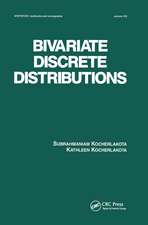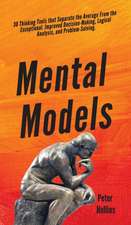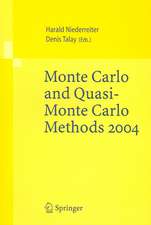Learning Regression Analysis by Simulation
Autor Kunio Takezawaen Limba Engleză Hardback – 22 oct 2013
This book, however, takes a slightly different approach, using simulation data instead of actual data to illustrate the functions of statistical methods. Also, R programs listed in the book help readers realize clearly how these methods work to bring intrinsic values of data to the surface. R is free software enabling users to handle vectors, matrices, data frames, and so on.
For example, when a statistical theory indicates that an event happens with a 5 % probability, readers can confirm the fact using R programs that this event actually occurs with roughly that probability, by handling data generated by pseudo-random numbers. Simulation gives readers populations with known backgrounds and the nature of the population can be adjusted easily. This feature of the simulation data helps provide a clear picture of statistical methods painlessly.
Most readers of introductory books of statistics for practical purposes do not like complex mathematical formulae, but they do not mind using a PC to produce various numbers and graphs by handling a huge variety of numbers. If they know the characteristics of these numbers beforehand, they treat them with ease. Struggling with actual data should come later. Conventional books on this topic frighten readers by presenting unidentified data to them indiscriminately. This book provides a new path to statistical concepts and practical skills in a readily accessible manner.
| Toate formatele și edițiile | Preț | Express |
|---|---|---|
| Paperback (1) | 389.11 lei 6-8 săpt. | |
| Springer – 27 sep 2016 | 389.11 lei 6-8 săpt. | |
| Hardback (1) | 396.62 lei 6-8 săpt. | |
| Springer – 22 oct 2013 | 396.62 lei 6-8 săpt. |
Preț: 396.62 lei
Nou
Puncte Express: 595
Preț estimativ în valută:
75.89€ • 82.70$ • 63.95£
75.89€ • 82.70$ • 63.95£
Carte tipărită la comandă
Livrare economică 24 aprilie-08 mai
Preluare comenzi: 021 569.72.76
Specificații
ISBN-13: 9784431543206
ISBN-10: 4431543201
Pagini: 312
Ilustrații: XII, 300 p. 88 illus.
Dimensiuni: 155 x 235 x 22 mm
Greutate: 0.62 kg
Ediția:2014
Editura: Springer
Colecția Springer
Locul publicării:Tokyo, Japan
ISBN-10: 4431543201
Pagini: 312
Ilustrații: XII, 300 p. 88 illus.
Dimensiuni: 155 x 235 x 22 mm
Greutate: 0.62 kg
Ediția:2014
Editura: Springer
Colecția Springer
Locul publicării:Tokyo, Japan
Public țintă
GraduateCuprins
Chapter 1 Linear algebra. Starting up and executing R. Vectors. Matrices. Addition of two matrices. Multiplying two matrices. Identity and inverse matrices. Simultaneous equations. Diagonalization of a symmetric matrix. Quadratic forms.– Chapter 2 Distributions and tests. Sampling and random variables. Probability distribution. Normal distribution and the central limit theorem. Interval estimation by t distribution. t-test. Intervalestimation of population variance and the χ2 distribution. Fdistribution and F-test. Wilcoxon signed-rank sum test.– Chapter 3 Simple regression. Derivation of regression coefficients. Exchange between predictor variable and target variable. Regression to the mean. Confidence interval of regression coefficients in simple regression. t-Test in simple regression. F-teston simple regression. Selection between constant and nonconstant regression equations. Prediction error of simple regression. Weighted regression. Least squares method and prediction error.– Chapter 4 Multiple regression. Derivation of regression coefficients. Test on multiple regression. Prediction error on multiple regression. Notes on model selection using prediction error. Polynomial regression. Variance of regression coefficient and multicollinearity. Detection of multicollinearity using Variance Inflation Factors. Hessian matrix of log-likelihood.– Chapter 5 Akaike's Information Criterion (AIC) and the third variance. Cp and FPE. AIC of a multiple regression equation with independent and identical normal distribution. Derivation of AIC for multiple regression. AIC with unbiased estimator for error variance. Error variance by maximizing expectation of log-likelihood in light of the data in the future and the “third variance.” Relationship between AIC (or GCV) and F-test. AIC on Poisson regression.– Chapter 6 Linear mixed model. Random-effects model. Random intercept model. Random intercept and slope model. Generalized linear mixedmodel. Generalized additive mixed model.
Recenzii
From the reviews:
“The book uses a slightly different approach to teach applied statistics. … The free software R has been used to make easy-to-use the statistical techniques considered in the book … . the book is dedicated to readers of introductory texts in statistics, mainly for practical purposes.” (Marina Gorunescu, zbMATH, Vol. 1281, 2014)
“The book uses a slightly different approach to teach applied statistics. … The free software R has been used to make easy-to-use the statistical techniques considered in the book … . the book is dedicated to readers of introductory texts in statistics, mainly for practical purposes.” (Marina Gorunescu, zbMATH, Vol. 1281, 2014)
Notă biografică
Kunio Takezawa is senior research scientist at the National Agricultural Research Center of Japan and an associate professor in the Graduate School of Life and Environmental Sciences at the University of Tsukuba. He received B.A. and M.A. degrees in applied physics from Nagoya University and a Ph.D. in agricultural science from the University of Tokyo. Dr.Takezawa has served as a researcher at the National Institute of Agro-Environmental Sciences and as a senior researcher at the Hokuriku Agricultural Experiment Station. He and H. Omori (Tokyo University) translated Jeffrey S. Simonoff’s Smoothing Methodsin Statistics (Springer, 1996), which was published as Heikatsuka to nonparametric kaiki heno syotai by Norintokei-kyokaiin 1999 as the first Japanese textbook on nonparametric regression. He was recognized with awards from the Japan Science and Technology Agency in 1997 and the Japanese Agricultural Systems Society in 2002. Dr. Takezawa holds several patents for his inventions.
Textul de pe ultima copertă
The standard approach of most introductory books for practical statistics is that readers first learn the minimum mathematical basics of statistics and rudimentary concepts of statistical methodology. They then are given examples of analyses of data obtained from natural and social phenomena so that they can grasp practical definitions of statistical methods. Finally they go on to acquaint themselves with statistical software for the PC and analyze similar data to expand and deepen their understanding of statistical methods.
This book, however, takes a slightly different approach, using simulation data instead of actual data to illustrate the functions of statistical methods. Also, "R" programs listed in the book help readers realize clearly how these methods work to bring intrinsic values of data to the surface. "R" is free software enabling users to handle vectors, matrices, data frames, and so on.
For example, when a statistical theory indicates that an event happens with a 5 % probability, readers can confirm the fact using "R" programs that this event actually occurs with roughly that probability, by handling data generated by pseudo-random numbers. Simulation gives readers populations with known backgrounds and the nature of the population can be adjusted easily. This feature of the simulation data helps provide a clear picture of statistical methods painlessly.
Most readers of introductory books of statistics for practical purposes do not like complex mathematical formulae, but they do not mind using a PC to produce various numbers and graphs by handling a huge variety of numbers. If they know the characteristics of these numbers beforehand, they treat them with ease. Struggling with actual data should come later. Conventional books on this topic frighten readers by presenting unidentified data to them indiscriminately. This book provides a new path to statistical concepts and practical skills in a readily accessible manner.
This book, however, takes a slightly different approach, using simulation data instead of actual data to illustrate the functions of statistical methods. Also, "R" programs listed in the book help readers realize clearly how these methods work to bring intrinsic values of data to the surface. "R" is free software enabling users to handle vectors, matrices, data frames, and so on.
For example, when a statistical theory indicates that an event happens with a 5 % probability, readers can confirm the fact using "R" programs that this event actually occurs with roughly that probability, by handling data generated by pseudo-random numbers. Simulation gives readers populations with known backgrounds and the nature of the population can be adjusted easily. This feature of the simulation data helps provide a clear picture of statistical methods painlessly.
Most readers of introductory books of statistics for practical purposes do not like complex mathematical formulae, but they do not mind using a PC to produce various numbers and graphs by handling a huge variety of numbers. If they know the characteristics of these numbers beforehand, they treat them with ease. Struggling with actual data should come later. Conventional books on this topic frighten readers by presenting unidentified data to them indiscriminately. This book provides a new path to statistical concepts and practical skills in a readily accessible manner.




























